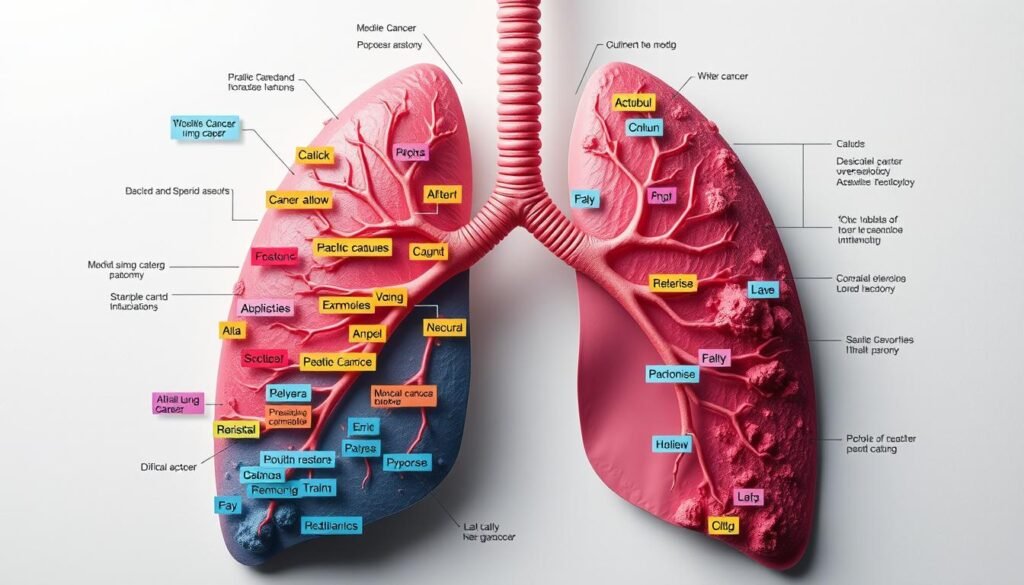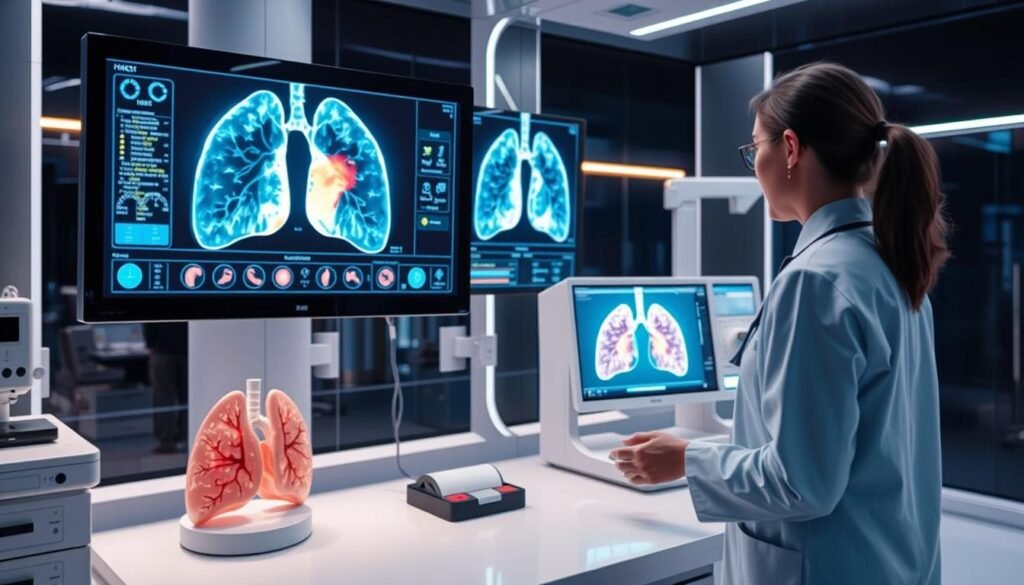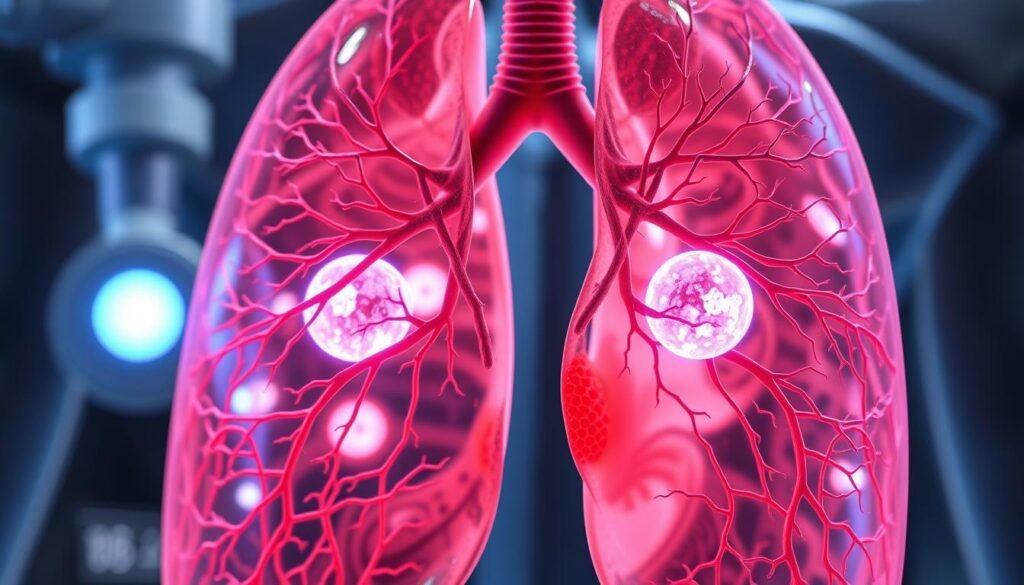Lung cancer causes about 25% of all cancer-related deaths in the U.S. Being the top cause of cancer deaths, it’s vital to know the different types and their codes. The ICD-10 codes are key for correct lung cancer detection, treatment, and paperwork for insurance. Learning about lung cancer helps doctors talk clearly about it. They can treat it better too.
Knowing the types of lung cancer is key for good care. This includes small cell and non-small cell cancers. It’s also critical to use the right lung cancer code. This makes sure patients get the best care. And it helps keep track of how treatments work and how the disease changes.
Key Takeaways
- Lung cancer accounts for a significant percentage of cancer deaths in the U.S.
- ICD-10 coding plays a vital role in identifying and classifying lung cancer types.
- Understanding lung cancer code is key for effective patient treatment and management.
- Small cell lung cancer and non-small cell lung cancer have distinct characteristics and coding requirements.
- Accurate coding is essential for healthcare documentation and insurance reimbursements.
- Tracking lung cancer cases helps in public health monitoring and research.
Introduction to Lung Cancer and Its Importance
Lung cancer is a major health issue worldwide, leading to many deaths. It’s estimated that in the United States, over 219,440 new cases of lung cancer were expected in 2009. This highlights the need for early awareness and effective treatments. The importance of lung cancer treatment is clear because proper care can greatly improve patient outcomes.
It’s critical to know the different lung cancer types. Most lung cancers are non-small cell, making up 85% to 90% of cases. Small cell lung cancer accounts for about 15%. Knowing the type helps doctors create the best treatment plans.
Lung cancer affects many, making up about 28% of all cancer deaths in men and 26% in women. Smoking is the cause of nearly 90% of these cases. Teaching people about the risks of smoking and secondhand smoke is crucial. Early detection is key. Patients found with early-stage lung cancer have a much better chance of survival than those diagnosed later.
Understanding lung cancer types and risks is vital for reducing its impact. By promoting prevention and effective treatments, we can improve health outcomes for those with lung cancer.
Understanding Lung Cancer Types
Lung cancer includes various types, like Small Cell Lung Cancer and Non-Small Cell Lung Cancer. Carcinoid tumors are also a category. Each kind has different traits and treatments.
Small Cell Lung Cancer (SCLC)
Small Cell Lung Cancer grows quickly and is aggressive. It’s mostly caused by smoking. It has two types: small cell carcinoma and mixed small/large cell cancer.
This cancer’s fast growth means finding it early is key. Often, it spreads before showing symptoms.
Non-Small Cell Lung Cancer (NSCLC)
Non-Small Cell Lung Cancer is the most common, making up about 80% of cases. It’s divided into subtypes, like adenocarcinoma, squamous cell carcinoma, and large cell carcinoma, based on the cells involved.
Adenocarcinoma starts in the lung’s outer parts. Squamous cell carcinoma is found near the bronchial tubes. Large cell carcinoma can grow anywhere in the lung and tends to expand quickly.
Carcinoid Tumors
Carcinoid tumors are less common and grow slower. They are split into typical or atypical types. Surgery is often used to treat them.
Distinguishing Between Small Cell and Non-Small Cell Lung Cancer
Knowing the difference between lung cancer types is key for right treatment. Small cell lung cancer (SCLC) and non-small cell lung cancer (NSCLC) have unique traits. These traits affect diagnosis and the outlook of the disease greatly. The next parts will talk about the small cell characteristics and non-small cell characteristics.
Characteristics of Small Cell Lung Cancer
SCLC is found in 15–20% of all lung cancer cases. It’s aggressive and spreads fast, which often leads to a worse outlook. Despite a good response to chemotherapy, survival rates are low.
This type of cancer grows and spreads quickly. That’s why finding it early is so important.
Characteristics of Non-Small Cell Lung Cancer
NSCLC is more common, with 80–85% of lung cancer cases falling into this category. It includes adenocarcinoma, squamous cell carcinoma, and large cell carcinoma. These subtypes grow differently and respond differently to treatment.
The NSCLC Case-Finding Algorithm is notably effective, with a sensitivity of 94.8% and specificity of 81.1%. It’s great at finding the disease early. This is crucial because NSCLC kinds vary a lot. More on distinguishing lung cancer types is available here.
| Feature | Small Cell Lung Cancer | Non-Small Cell Lung Cancer |
|---|---|---|
| Prevalence | 15–20% | 80–85% |
| Prognosis | Generally poorer | Better with early detection |
| Treatment Response | Highly responsive to chemotherapy | Varies by subtype |
| Growth Rate | Rapid | Variable |
| Primary Subtypes | None | Adenocarcinoma, Squamous Cell Carcinoma, Large Cell Carcinoma |
Details of Lung Cancer Subtypes
It’s vital to understand the different kinds of lung cancer for proper diagnosis and treatment. The main lung cancer subtypes are adenocarcinoma, squamous cell carcinoma, and large cell carcinoma. Each kind has its own way of acting, growing, and how doctors treat it.
Adenocarcinoma
Adenocarcinoma is the most common type, often found in non-smokers. It starts in the lungs’ outer parts. This kind is known for looking different under the microscope, with many variations. Its rise in both men and women makes early finding and knowing about it very important.
Squamous Cell Carcinoma
Squamous cell carcinoma usually develops in the lungs’ middle areas and is tied to smoking. This cancer’s growth can cause major health issues, so close watch is needed. If you have a constant cough and chest pain, it might be this cancer. Timely doctor visits are key. Learn more about warning signs here.
Large Cell Carcinoma
Large cell carcinoma grows fast and can be quite aggressive. It’s a type of non-small cell cancer that’s hard to treat. It can start anywhere in the lung and tends to spread quickly. This means it needs fast and strong treatment approaches.
| Lung Cancer Subtype | Location | Association with Smoking | Growth Rate |
|---|---|---|---|
| Adenocarcinoma | Outer areas of lungs | Less common in smokers | Moderate |
| Squamous Cell Carcinoma | Central lung regions | Common in smokers | Moderate to rapid |
| Large Cell Carcinoma | Any part of the lung | Variable | Rapid |
Understanding the Lung Cancer Code
Lung cancer is a major health issue. It is the second most common cancer in the United States. It’s also the top cause of cancer-related deaths. The lung cancer code helps doctors plan effective treatments. It makes treatment consistent across healthcare. Coding systems, like ICD coding, classify lung cancer types consistently.
Knowing the differences in lung cancer codes is crucial. It helps tell apart small cell lung cancer from non-small cell lung cancer. These differences affect patient care and treatment options. Small cell lung cancer is linked to cigarette smoking. It has specific ICD-10 codes, such as C34.2. These codes identify certain cancers in the bronchus and lungs. For more information, check out this detailed guide.
Correct coding is key for doctors to make proper treatment plans. It helps medical billers adhere to regulations. Following these coding practices improves data reporting. This is vital given lung cancer’s low five-year survival rate of 20.5%.
Recently, changes in insurance coverage have highlighted the importance of coding. This includes Medicare and Medicaid changes. Understanding lung cancer codes is crucial. It ensures patients get the needed screenings and treatments in time.
ICD-10 Coding System for Lung Cancer
The ICD-10 coding system is key in healthcare. It gives uniform codes for diseases like lung cancer. This helps doctors accurately record, categorize, and bill lung cancer treatments.
Importance of ICD-10 Codes in Healthcare
ICD-10 codes are very important. They let healthcare workers share precise diagnoses. Correctly coding lung cancer improves treatment plans and care coordination.
For example, codes like C34.0 for main bronchus cancers are crucial. They help pinpoint the cancer’s location and type. This is essential for treatment choices and research.
Examples of Lung Cancer ICD-10 Codes
Doctors use many lung cancer ICD-10 codes. Here are some examples:
| ICD-10 Code | Description |
|---|---|
| C34.0 | Malignant neoplasm of the main bronchus |
| C34.1 | Malignant neoplasm of the upper lobe, bronchus, or lung |
| C34.2 | Malignant neoplasm of the middle lobe, bronchus, or lung |
| C34.3 | Malignant neoplasm of the lower lobe, bronchus, or lung |
| C34.9 | Malignant neoplasm of unspecified part of bronchus or lung |
| Z77.22 | Exposure to environmental tobacco smoke |
These codes show the ICD-10 system’s variety. Codes like C34.8 for overlapping sites are vital. They give important data for studies and checking treatment success. For updates on lung cancer treatments, go to this resource.

Machine Learning Applications in Lung Cancer Diagnosis
Lung cancer diagnosis is tough, needing new ways to up accuracy and speed. Every year, around 2.20 million people worldwide are diagnosed with lung cancer. Sadly, 75% of them die within five years of finding out they have it. This facts underline the critical need for better diagnostic methods.
Machine learning is changing how we diagnose lung cancer. It offers a helpful second opinion for doctors, helping them make better care decisions. Traditional tasks like spotting nodules and pulling out features use algorithms such as logistic regression and linear discriminant analysis. These tools help read imaging data better, making the process more accurate and reducing mistakes.
Deep learning introduces another method with convolutional neural networks. These networks can identify features in nodules on their own. This tech aims to lower the chance of misdiagnosis, make detection faster, and boost overall accuracy in spotting lung cancer.
Different machine learning algorithms are also key in making clinical choices about lung cancer. Techniques like random forest, support vector machine, and neural networks are common. They use big imaging datasets to give powerful diagnostic suggestions. This helps doctors understand more about the patient’s condition and the tumor’s nature.
| Features | Traditional CAD | DL-based CAD |
|---|---|---|
| Process | Nodule segmentation, feature extraction | Automatic feature extraction |
| Algorithm Examples | Logistic Regression, LDA | Convolutional Neural Networks |
| Accuracy | Good but limited | Higher, reduced false positive rates |
| Time Efficiency | Longer execution time | Faster detection |
Machine learning doesn’t just help diagnose lung cancer. It also helps create personalized treatment plans. This means faster help for those at high risk. It considers things like age, if someone smokes, and other health issues. As these AI technologies get better, they could greatly change lung cancer care and patient results.
Computer-Aided Diagnosis and its Role in Lung Cancer Detection
Lung cancer is a leading cause of death from cancer. Early diagnosis and treatment can be hard to achieve. Computer-aided diagnosis (CAD) helps improve lung cancer detection. Using advanced algorithms, CAD aids radiologists in spotting lung nodules.
CAD technology follows a specific process. This includes analyzing the lungs, finding nodules, and figuring out if they are benign or malignant. Studies show CAD boosts lung cancer detection rates from 77% to 84%. Radiologists perform better in spotting nodules with CAD’s help.

Public databases like LIDC and ANODE09 train CAD systems. They allow for comparison among algorithms. CAD not only finds potential cancers but also reduces false alarms. This means fewer unneeded procedures and less anxiety for patients. The U.S. Preventive Services Task Force reported CT scans can cut lung cancer death rates by at least 20% in those at high risk.
The rise of AI in diagnosis shows technology’s power to better healthcare. Partnerships with companies like DeepHealth and Apollo Radiology International are making lung cancer screenings more precise and efficient. Advanced CAD techniques aim to improve patient outcomes against lung cancer.
For more details on CAD’s effectiveness in detecting lung cancer, check out this research study. It highlights recent advancements and the important role of these tools in oncology.
Emerging Technologies in AI-Assisted Cancer Screening
The field of cancer screening has changed a lot with emerging technologies. This is especially true for deep learning for radiology. These changes help doctors find and diagnose lung cancer better than before.
Deep Learning in Radiology for Lung Cancer
Deep learning algorithms are changing how doctors look at images for lung cancer. The use of AI, like the ClearRead platform, makes finding lung nodules easier. Research shows it boosts doctors’ ability to spot lung nodules from 64.5% to 80%. Also, ClearRead speeds up reading times by 26% and finds 30% more nodules that could be cancer.
In the Greater Cincinnati area, lung cancer rates are higher than the national average. Yet, only 7% of people get screened. This shows a big need for better early screening. Thanks to deep learning, doctors can now find early-stage lung cancer in up to 90% of cases. This could lead to treatments that cure the cancer.
Benefits of Automated Cancer Staging
Automated cancer staging is another big step forward in AI-assisted cancer screening. It uses deep learning to help radiologists stage cancer more quickly and accurately. This makes it easier to take care of patients. It helps doctors give the right treatment sooner. AI systems have proven to be reliable, with a sensitivity and specificity rate of 0.87 each.
These new technologies are making lung cancer screening better. They help find cancer earlier and improve how patients are treated. With more doctors using AI, we can hope to see fewer late-stage cancer diagnoses. Late-stage lung cancer has low survival rates, with only 20-30% of patients living five years after being diagnosed.
For more details on the ongoing projects and the development of these technologies, visit the Artificial Intelligence Resource. It shows how AI is changing cancer research and making screening better.
Pulmonary Nodule Analysis and Lung Tumor Segmentation
Understanding pulmonary nodules is key in lung cancer battle. Accurate spotting and mapping of lung nodules are vital. This is because non-small cell lung cancer (NSCLC) makes up 80% to 85% of all lung cancer cases. It includes types like adenocarcinoma and squamous cell carcinoma. Early and right detection with CT scans can find small lesions. These might be missed with just X-ray images.
However, lung tumor segmentation faces challenges. Variability in nodule features like size, shape, and texture makes it tough. Around 30% of lung nodules are missed in regular check-ups. This shows the need for better methods. AI in oncology is leading new solutions. Computer-Aided Detection (CAD) systems help radiologists. They cut down on manual errors and boost accuracy in finding tumors.

Many recent models have shown great results in lung tumor mapping. Studies report high Dice similarity coefficients. For example, one is 94.9% on the LUNA16 dataset and another is 81.1% on the LNDb dataset. This marks a big step forward in how accurate these models are.
Advancements include using multi-view convolutional neural networks. They reached a DSC of 77.67%. Also, better models, like those with an improved U-Net network, have seen DSCs of 82.82%. This shows the continuous growth of techniques in this area.
New developments in pulmonary nodule analysis and changes in lung tumor segmentation will improve tumor detection and classification. The rise of AI and deep learning brings new hope. They could change how we find and diagnose lung cancers.
Conclusion
Understanding lung cancer deeply matters for everyone in healthcare and for patients too. We looked into lung cancer codes and classifications. These are important for correct diagnosis, patient care, and treatment planning. Also, medical documents like pathology reports are key.
Using new tech and standard codes helps deal with lung cancer’s complex nature. Techniques like machine learning and automated staging make diagnosis and treatment better and faster. This means healthcare workers can give top-notch care to patients.
As healthcare grows, so does how we treat lung cancer. Embracing new methods, working together, and knowing the coding systems helps tackle lung cancer challenges. This leads to better care and life quality for patients.